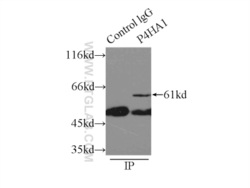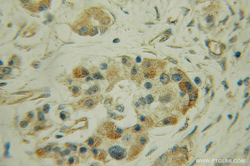Antibody data
- Antibody Data
- Antigen structure
- References [22]
- Comments [0]
- Validations
- Western blot [1]
- Immunoprecipitation [1]
- Immunohistochemistry [1]
Submit
Validation data
Reference
Comment
Report error
- Product number
- 12658-1-AP - Provider product page

- Provider
- Proteintech Group
- Proper citation
- Proteintech Cat#12658-1-AP, RRID:AB_2283162
- Product name
- P4HA1 antibody
- Antibody type
- Polyclonal
- Description
- KD/KO validated P4HA1 antibody (Cat. #12658-1-AP) is a rabbit polyclonal antibody that shows reactivity with human, mouse, rat and has been validated for the following applications: IF, IHC, IP, WB, ELISA.
- Reactivity
- Human, Mouse, Rat
- Host
- Rabbit
- Conjugate
- Unconjugated
- Isotype
- IgG
- Vial size
- 20ul, 150ul
Submitted references Hypoxia-induced P4HA1 overexpression promotes post-ischemic angiogenesis by enhancing endothelial glycolysis through downregulating FBP1.
Lactate-driven type I collagen deposition facilitates cancer stem cell-like phenotype of head and neck squamous cell carcinoma.
P4HA1 activates HMGCS1 to promote nasopharyngeal carcinoma ferroptosis resistance and progression.
Developmental growth plate cartilage formation suppressed by artificial light at night via inhibiting BMAL1-driven collagen hydroxylation.
Exploring the glycolytic cross-talk genes between inflammatory bowel disease and colorectal cancer.
P4HA1 expression and function in esophageal squamous cell carcinoma.
P4HA1, transcriptionally activated by STAT1, promotes esophageal cancer progression.
IL-17-induced HIF1α drives resistance to anti-PD-L1 via fibroblast-mediated immune exclusion.
P4HA1 Down-Regulation Inhibits Glioma Invasiveness by Promoting M1 Microglia Polarization.
Overexpression of P4HA1 associates with poor prognosis and promotes cell proliferation and metastasis of lung adenocarcinoma.
P4HA1 as an unfavorable prognostic marker promotes cell migration and invasion of glioblastoma via inducing EMT process under hypoxia microenvironment.
Identification of a novel glycolysis-related gene signature for predicting the prognosis of osteosarcoma patients.
Cotranslational prolyl hydroxylation is essential for flavivirus biogenesis.
HIF-1α interacts with Kindlin-2 and influences breast cancer elasticity: A study based on shear wave elastography imaging.
Prolyl 4-hydroxylase subunit alpha 1 (P4HA1) is a biomarker of poor prognosis in primary melanomas, and its depletion inhibits melanoma cell invasion and disrupts tumor blood vessel walls.
MiR-122 inhibits epithelial mesenchymal transition by regulating P4HA1 in ovarian cancer cells.
P4HA1 mutations cause a unique congenital disorder of connective tissue involving tendon, bone, muscle and the eye.
MiR-30e suppresses proliferation of hepatoma cells via targeting prolyl 4-hydroxylase subunit alpha-1 (P4HA1) mRNA.
Extracellular matrix remodeling by bone marrow fibroblast-like cells correlates with disease progression in multiple myeloma.
The miR-124-prolyl hydroxylase P4HA1-MMP1 axis plays a critical role in prostate cancer progression.
The effect of isosaponarin isolated from wasabi leaf on collagen synthesis in human fibroblasts and its underlying mechanism.
The reverse Warburg effect: aerobic glycolysis in cancer associated fibroblasts and the tumor stroma.
Xu Y, Xia D, Huang K, Liang M
Journal of translational medicine 2024 Jan 18;22(1):74
Journal of translational medicine 2024 Jan 18;22(1):74
Lactate-driven type I collagen deposition facilitates cancer stem cell-like phenotype of head and neck squamous cell carcinoma.
Sun Y, Chen Y, Zhao H, Wang J, Liu Y, Bai J, Hu C, Shang Z
iScience 2024 Apr 19;27(4):109340
iScience 2024 Apr 19;27(4):109340
P4HA1 activates HMGCS1 to promote nasopharyngeal carcinoma ferroptosis resistance and progression.
Zhou R, Qiu L, Zhou L, Geng R, Yang S, Wu J
Cellular signalling 2023 May;105:110609
Cellular signalling 2023 May;105:110609
Developmental growth plate cartilage formation suppressed by artificial light at night via inhibiting BMAL1-driven collagen hydroxylation.
Chen G, Tang Q, Yu S, Shen Y, Sun J, Peng J, Yin Y, Feng G, Lu X, Mei G, Zhang Y, Wan Q, Zhang L, Chen L
Cell death and differentiation 2023 Jun;30(6):1503-1516
Cell death and differentiation 2023 Jun;30(6):1503-1516
Exploring the glycolytic cross-talk genes between inflammatory bowel disease and colorectal cancer.
Ye C, Huang Y, Gao Y, Zhu S, Yuan J
Functional & integrative genomics 2023 Jul 10;23(3):230
Functional & integrative genomics 2023 Jul 10;23(3):230
P4HA1 expression and function in esophageal squamous cell carcinoma.
Gou W, Song B, Yang Y
Medicine 2023 Dec 22;102(51):e36800
Medicine 2023 Dec 22;102(51):e36800
P4HA1, transcriptionally activated by STAT1, promotes esophageal cancer progression.
Gou W, Yang Y, Shan Q, Xia S, Ma Y
Pathology international 2023 Apr;73(4):147-158
Pathology international 2023 Apr;73(4):147-158
IL-17-induced HIF1α drives resistance to anti-PD-L1 via fibroblast-mediated immune exclusion.
Chen X, Zhao J, Herjan T, Hong L, Liao Y, Liu C, Vasu K, Wang H, Thompson A, Fox PL, Gastman BR, Li X, Li X
The Journal of experimental medicine 2022 Jun 6;219(6)
The Journal of experimental medicine 2022 Jun 6;219(6)
P4HA1 Down-Regulation Inhibits Glioma Invasiveness by Promoting M1 Microglia Polarization.
Wang Q, Zhang J, Fang S, Wang J, Han X, Liu F, Jin G
OncoTargets and therapy 2021;14:1771-1782
OncoTargets and therapy 2021;14:1771-1782
Overexpression of P4HA1 associates with poor prognosis and promotes cell proliferation and metastasis of lung adenocarcinoma.
Ning Y, Zheng H, Zhan Y, Liu S, Yang Y, Zang H, Wen Q, Zhang Y, Fan S
Journal of Cancer 2021;12(22):6685-6694
Journal of Cancer 2021;12(22):6685-6694
P4HA1 as an unfavorable prognostic marker promotes cell migration and invasion of glioblastoma via inducing EMT process under hypoxia microenvironment.
Zhu X, Liu S, Yang X, Wang W, Shao W, Ji T
American journal of cancer research 2021;11(2):590-617
American journal of cancer research 2021;11(2):590-617
Identification of a novel glycolysis-related gene signature for predicting the prognosis of osteosarcoma patients.
Yang M, Ma X, Wang Z, Zhang T, Hua Y, Cai Z
Aging 2021 May 5;13(9):12896-12918
Aging 2021 May 5;13(9):12896-12918
Cotranslational prolyl hydroxylation is essential for flavivirus biogenesis.
Aviner R, Li KH, Frydman J, Andino R
Nature 2021 Aug;596(7873):558-564
Nature 2021 Aug;596(7873):558-564
HIF-1α interacts with Kindlin-2 and influences breast cancer elasticity: A study based on shear wave elastography imaging.
Xue X, Xue S, Wan W, Li J, Shi H
Cancer medicine 2020 Jul;9(14):4971-4979
Cancer medicine 2020 Jul;9(14):4971-4979
Prolyl 4-hydroxylase subunit alpha 1 (P4HA1) is a biomarker of poor prognosis in primary melanomas, and its depletion inhibits melanoma cell invasion and disrupts tumor blood vessel walls.
Eriksson J, Le Joncour V, Jahkola T, Juteau S, Laakkonen P, Saksela O, Hölttä E
Molecular oncology 2020 Apr;14(4):742-762
Molecular oncology 2020 Apr;14(4):742-762
MiR-122 inhibits epithelial mesenchymal transition by regulating P4HA1 in ovarian cancer cells.
Duan Y, Dong Y, Dang R, Hu Z, Yang Y, Hu Y, Cheng J
Cell biology international 2018 Nov;42(11):1564-1574
Cell biology international 2018 Nov;42(11):1564-1574
P4HA1 mutations cause a unique congenital disorder of connective tissue involving tendon, bone, muscle and the eye.
Zou Y, Donkervoort S, Salo AM, Foley AR, Barnes AM, Hu Y, Makareeva E, Leach ME, Mohassel P, Dastgir J, Deardorff MA, Cohn RD, DiNonno WO, Malfait F, Lek M, Leikin S, Marini JC, Myllyharju J, Bönnemann CG
Human molecular genetics 2017 Jun 15;26(12):2207-2217
Human molecular genetics 2017 Jun 15;26(12):2207-2217
MiR-30e suppresses proliferation of hepatoma cells via targeting prolyl 4-hydroxylase subunit alpha-1 (P4HA1) mRNA.
Feng G, Shi H, Li J, Yang Z, Fang R, Ye L, Zhang W, Zhang X
Biochemical and biophysical research communications 2016 Apr 8;472(3):516-22
Biochemical and biophysical research communications 2016 Apr 8;472(3):516-22
Extracellular matrix remodeling by bone marrow fibroblast-like cells correlates with disease progression in multiple myeloma.
Slany A, Haudek-Prinz V, Meshcheryakova A, Bileck A, Lamm W, Zielinski C, Gerner C, Drach J
Journal of proteome research 2014 Feb 7;13(2):844-54
Journal of proteome research 2014 Feb 7;13(2):844-54
The miR-124-prolyl hydroxylase P4HA1-MMP1 axis plays a critical role in prostate cancer progression.
Chakravarthi BV, Pathi SS, Goswami MT, Cieślik M, Zheng H, Nallasivam S, Arekapudi SR, Jing X, Siddiqui J, Athanikar J, Carskadon SL, Lonigro RJ, Kunju LP, Chinnaiyan AM, Palanisamy N, Varambally S
Oncotarget 2014 Aug 30;5(16):6654-69
Oncotarget 2014 Aug 30;5(16):6654-69
The effect of isosaponarin isolated from wasabi leaf on collagen synthesis in human fibroblasts and its underlying mechanism.
Nagai M, Akita K, Yamada K, Okunishi I
Journal of natural medicines 2010 Jul;64(3):305-12
Journal of natural medicines 2010 Jul;64(3):305-12
The reverse Warburg effect: aerobic glycolysis in cancer associated fibroblasts and the tumor stroma.
Pavlides S, Whitaker-Menezes D, Castello-Cros R, Flomenberg N, Witkiewicz AK, Frank PG, Casimiro MC, Wang C, Fortina P, Addya S, Pestell RG, Martinez-Outschoorn UE, Sotgia F, Lisanti MP
Cell cycle (Georgetown, Tex.) 2009 Dec;8(23):3984-4001
Cell cycle (Georgetown, Tex.) 2009 Dec;8(23):3984-4001
No comments: Submit comment
Supportive validation
- Submitted by
- Proteintech Group (provider)
- Main image

- Experimental details
- A431 cells were subjected to SDS PAGE followed by western blot with 12658-1-AP(P4HA1 antibody) at dilution of 1:600
- Sample type
- cell line
Supportive validation
- Submitted by
- Proteintech Group (provider)
- Main image

- Experimental details
- IP Result of anti-P4HA1 (IP:12658-1-AP, 3ug; Detection:12658-1-AP 1:600) with A431 cells lysate 3300ug.
- Sample type
- cell line
Supportive validation
- Submitted by
- Proteintech Group (provider)
- Main image

- Experimental details
- The P4HA1 antibody from Proteintech is a rabbit polyclonal antibody to a recombinant protein of human P4HA1. This antibody recognizes human,mouse,rat antigen. The P4HA1 antibody has been validated for the following applications: ELISA, WB, IHC, IP analysis.
 Explore
Explore Validate
Validate Learn
Learn Western blot
Western blot ELISA
ELISA